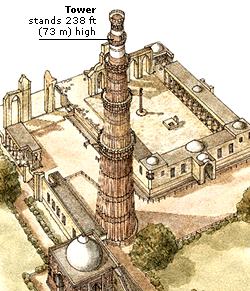DK History: Islamic Civilization
In AD 610, an Arab merchant called Muhammad founded a new religion called Islam. His teachings inspired the Arab peoples, and by 750 Muslims (followers of Islam) had conquered an area stretching from Afghanistan to AL ANDALUS in southern Spain. Trade, science, and culture thrived in this Islamic empire.
Newly conquered lands were united by Islam, and by common tax systems, coinage, and laws. Jews and Christians sometimes paid higher taxes, but they were free to run their own religious affairs so long as they did not insult the Prophet Muhammad.
Islam brought a new sense of unity and purpose to the traders and tribespeople of the Arabian Peninsula. Led by the CALIPH, Arab armies spread Islam in the Middle East and beyond. It helped that their main enemies, the Sassanids in Iran and the Byzantines in eastern Europe, were weakened by fighting each other. Islam was also spread by Muslim traders.
Muslim pilgrims, traders, soldiers, scholars, and government officials made long journeys across the Islamic empire and beyond. One of the most famous explorers, Ibn Battuta, set out on a pilgrimage to Mecca in 1325. He spent the next 25 years traveling, crossing the Sahara and even reaching China before returning to Morocco to write his story.
Many of the first Muslims were nomads, who needed to be able to pack up and move all their belongings quickly. Traditionally, woven cloth was used for tents, bags, clothes, cushions, bedding, and carpets. The art and craft of making textiles continued to be important in the Muslim world, which gave us the words for damask (from Damascus), muslin (from Mosul), and cashmere (from Kashmir).
After the death of Muhammad in 632, Muslims were ruled by caliphs. As Islam spread, the caliphs had great political as well as spiritual authority. In the reign of the fourth caliph, from 656 to 661, two rival traditions of Islam emerged: the Sunni and the Shi’a. This division meant it was no longer possible for the whole Islamic world to be ruled by a single caliph.
The Umayyads and Abbasids were dynasties of caliphs. From 661, Islam was ruled by the Umayyads, based in Damascus (in Syria). In 750, a new dynasty, the Abbasid, seized power, although a branch of the Umayyad continued to rule Muslim Spain. The Abbasid caliphs were based at Baghdad, which became the prosperous center of a huge trading empire and the artistic capital of the Muslim world.
Muslim armies conquered southern Spain in 711. They called it Al Andalus, and it became the richest country in Europe. The Muslims, or Moors as they are sometimes called, brought new crops, such as oranges, almonds, and cotton, and new technology, such as water wheels. In 1492, Granada, which was the last surviving Islamic kingdom in Spain, fell to Christian rulers.
During the 10th century reign of Abd al-Rahman, Cordoba was the capital of Al Andalus. With its lavishly endowed libraries, it was a magnet for scholars and acted as the door through which the science of the East reached Christian scholars in western Europe. After 1031, when the ruling dynasty changed, Cordoba’s golden age ended. In 1236 it was reconquered by Christian Spanish forces.

